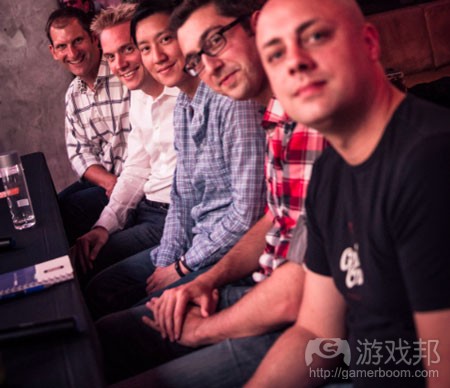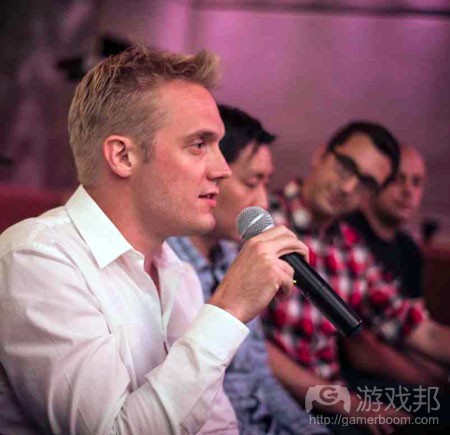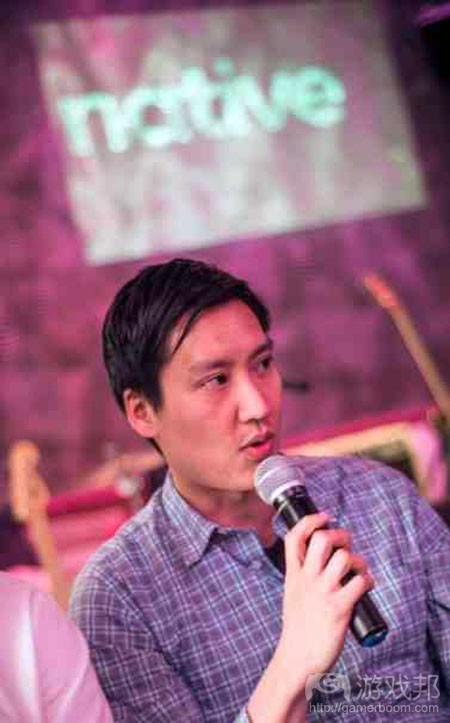业内人士探讨手机游戏市场发展趋势
作者:Martine Paris
在2013年Casual Connect旧金山大会的Pocket Gamer Super Mixer座谈会(由NativeX和Grand Cru主持)上,多名手机游戏开发者深入探讨了关于如何发行热门游戏、寻找哪种融资渠道,如何有效获取用户,以及最佳开发者资源等相关话题。
开场
本次座谈会首先展出了由Grand Gru开发的iOS城建免费游戏《Supernauts》——今年所谓的最具雄心的手机游戏之一。
Grand Gru首席执行官Markus Pasula和首席营销官Thorbjorn Warin宣布完成由IDinvest牵头的1100万美元A轮融资。
这两者首先向众人介绍了这款受到《Minecraft》启发的物理谜题游戏,该游戏含有令人上瘾的迷幻音轨,以及3D场景中的古怪卡通图像。
全明星阵容的座谈小组
本次座谈会成员包括Initial Capital联合创始人及合伙人Kristian Segerstrale(游戏邦注:他目前是Supercell董事会成员,此前曾是EA数字部门主管,Playfish和Glu Mobile联合创始人 )、Pocket Gems首席执行官Ben Liu、完美世界移动总经理Fabien-Pierre Nicolas,以及盈利服务供应商NativeX总经理兼副总裁Erik Lundberg。
大家讨论的第一个问题是“为何芬兰(在手机游戏领域)的地位如此重要?”
Thorbjorn Warin:赫尔辛基似乎有意成为全球的游戏中心。它是Supercell、Rovio、诺基亚、Digital Chocolate、Remedy、Sulake,当然还有Grand Gru等公司的总部所在地。
这同芬兰的文化支持力度有关。这里的文化旨在培养小型团队的合作意识,创造一种包容失败、接纳风险的氛围,所以创意在此得以繁荣发展。源源不断的人才,海外资金流,以及政府的扶持,也同样为这里的游戏行业创造了理想的发展环境。
独立开发者的黄金时代
触屏设备的爆炸式发展,市场范围扩张,更高的用户普遍率,更低的准入门槛,手机游戏市场出现空前的发展机遇。
大家开始进入一个人人皆是游戏玩家的时代,游戏成为一种大众活动,那么这就是我们这一行业的黄金时代吗?
Fabien-Pierre Nicolas: 没错,现在出现了第一代玩iPad长大的用户群体。随着《愤怒的小鸟》一代长大成为核心用户,他们对游戏体验的需求还会不断增长。
Warin:游戏是一种基本的人类社交需求。游戏、唱歌和讲故事这三种娱乐形式在人类文明之初就已经出现了。它是我们的一部分,也将成为我们做任何事情的一部分。
Ben Liu:这真是游戏开发者的一个美好时代。在未来2-3年,平板电脑和手机将疯狂发展。移动设备拥有最庞大的安装基数,最广泛的普遍率,最容易将游戏带到用户面前。平板电脑将成为史上最伟大的设备之一。
Kristian Segerstrale: 平板电脑的用户粘性已经超过主机设备,随着主机游戏玩家的比例下降,平板电脑游戏市场还将进一步扩大。大型发行商还在为下一代主机设备的发布而劳神时,独立开发者却可以借机大干一场。
自主发行还是寻找发行商合作?
Segerstrale:之前市场上从未出现如此之多的自主发行工具。现在你可以制作游戏,并用很实惠的手段将其推向市场。从市场营销角度来看,你并不需要投入数百万美元来支持一款游戏的发行工作。
你只需要创造一个很棒的产品,将其投向加拿大或新西兰,证明你可以从中创收成百上千美元,然后由其他相信这款游戏会获得成功的人来投资,填补剩下的资金空缺。另一种方法是游说一家发行商,以游戏的部分价值来换取一些短期的服务。
Liu:手中掌握资源的开发者和初出茅庐的新手之间还是有区别的。如果你是一家小型公司,你想为自己的产品找到用户,就可以借发行商之手实现这个目标。自己同所有的广告网络打交道是一项棘手任务。如果你是一个10人团队,相信你更情愿把时间用于制作游戏。
像《Temple Run》等一些最为杰出的产品就是由5-10人团队开发而成。Pocket Gems最开始也只有2个人,寻找早期用户成了我们成功的关键。我们用了4年时间创造工具和技术,使用了100多种不同渠道以便有效获取用户,并打造了一个下载量超过1.2亿次的游戏网络。
在当今世界发行一款游戏是一个极为复杂的过程,与发行商合作可以获得一些重要的资源,技术和专业知识。如果你想进入一个新市场,一切都要取决于制作一款出色的游戏,而这又是极为困难并且需要极大专注力的事情。
从小处开始,控制规模,制作纯粹而有趣的内容,并进行迭代。这仍然很有可能让你制作出一炮走红的游戏。我并不赞成资源或时间有限的开发者,花时间去考虑用户获取的问题。
Nicolas:用25万-50万美元来制作游戏,再加3万-5万来试发布游戏,这已经是一笔不小的数目了。如果是硬核游戏,这一成本还会更高。如果你并没有什么阔绰的朋友,你可能就得寻找发行商。如果你是一个开发预算为100万美元,但却没有200万-300万美元来获取用户的工作室,那你就得找发行商合作了。
但要记住,你并不需要将大部分利益出让给发行商,你可以保留自己的IP。要签订能够保持长期公平的合同。要在合同中注明你需要他们将你引向谷歌和苹果平台,让你获得KPI等信息。要先问问你的LTV(用户终身价值)方法是什么?你如何试发行游戏?看看试发行阶段的收益分成,并进行计算确保你仍有余钱来迭代产品。如果发行商要抽成70-80%,不要说是为玩家制作更多内容了,恐怕你自己填饱肚子都不够呢。
Warin:如果你推出的是付费游戏,那就要去找发行商,这样你的团队就只需要集中精力制作好游戏。如果你的产品是F2P游戏,你就没必要去找发行商,但你也不能局限于5-6人的小型团队,因为你总得扩大规模,拥有非游戏相关的技能,你得了解分析和营销知识,而这不仅仅是花钱获取用户就能搞定,这还涉及引进新人才,并让他们参与团队的开发项目。
所以,对于付费游戏而言,选择与发行商合作无疑是一个好方法。对F2P游戏,那就未必如此了。
Erik Lundberg:市场有包括Kochava、HasOffers和Onavo等许多很棒的工具,可以帮助独立开发者起步。另外开发者还可以通过NativeX Games Task Force游戏专家团队的帮助,找到游戏早期的问题,并制定相应的用户留存、盈利、界面设计方案。有些公司就是通过这些改进建议提升了300%的销售额。
不要杀鸡取卵
随着F2P模式的兴起,我们开始看到每款游戏都围绕这一模式而设计,那么开发者如何避免玩家对此产生审美疲劳呢?
Segerstrale:在80年代,开发商还有可能不直接与用户打交道而制作和销售游戏。但现在F2P(免费模式)才是王道。你并不需要花钱买赢,你是被游戏系统所吸引,而非被敲诈。
但也有些游戏会玩这种伎俩,即给你一只小猫,但如果你两周之后还不付费,小猫身上就会发生一些可怕的情况。这并不是一种公平的模式。如果我们不及时制止,玩家迟早会出现审美疲劳,而在游戏设计上勇于创新者终将迎来更大的机遇。《Supernauts》就是在游戏玩法方面颇为进步的一个绝佳典型。
总结
最后一个问题——这个行业什么现象最让你兴奋?
Segerstrale: 最主要的是出现新型的出色游戏。但鉴于不断增长的营销预算,我对市场营销方面的快速发展也很感兴趣。明年手机游戏领域最大的创新应该出现的市场营销,以及游戏如何进入市场这个环节。
此外,Google Glass和手表等第二屏幕的发明也是如此。虽然手机和平板电脑很可能成为玩家的主要屏幕,但游戏开发者如何向这些第二屏幕引进游戏体验,确实值得期待。
Lundberg:我也认为在未来5年,可穿戴设备还会获得更大突破。我希望能够看到移动设备如何整合到更大的共享屏幕中。三星在移动和电视领域已经是佼佼者,这个领域的发展应该很有趣。、
此外我还关注移动社交游戏网络。Kakao的通信服务已经覆盖了韩国90%的人口,他们借此打造了一个游戏渠道,其中的顶级游戏日常收益超过了300万美元。日本这方面的领军力量是LINE,中国是腾讯的微信,西方市场的代表则是Tango(拥有1亿用户)。(本文为游戏邦/gamerboom.com编译,拒绝任何不保留版权的转载,如需转载请联系:游戏邦)
Advice from the PG Mixer Panel: Top tips for launching your game – with or without publishers
by Martine Paris
At the Pocket Gamer Super Mixer at Casual Connect 2013 San Francisco – sponsored by NativeX and Grand Cru – an all-star panel provided valuable insights to a packed room of mobile game developers.
Check out the photos here.
Topics covered included how to launch a break-out game, what type of funding to seek, how to acquire users profitably, and the best developer resources.
The Grand unveiling
The session opened with the first live public demo of what many are calling one of the most ambitious mobile games ever made, Grand Cru’s free-to-play iOS world-building game, Supernauts.
On stage were Grand Cru CEO Markus Pasula and CMO Thorbjorn Warin announcing the closing of their Series A round of $11 million led by IDinvest.
The Grand Cru crew
The duo began their presentation with a reveal of the game intro to the Minecraft-inspired physics puzzler, which features an addictive psychedelic-surf soundtrack and whimsical cartoon graphics in a 3D environment.
The game takes place in space and players travel to drowning Earth as a Supernaut to rescue it one block at a time.
The all-star panel
Following the Supernauts reveal, Warin joined the panel, which was anchored by industry luminary, Kristian Segerstrale.
Co-founder and partner of Initial Capital, he’s now a board member at Supercell, and was previously head of digital at Electronic Arts, and co-founder of Playfish and Glu Mobile.
The panel: from the left: Lundberg, Segerstrale, Liu, Nicolas and Warin
Other speakers were Ben Liu, CEO of Pocket Gems, Fabien-Pierre Nicolas, GM Mobile of Perfect World, – both companies are launching third-party publishing platforms – and Erik Lundberg, VP and general manager of NativeX, the monetization gurus.
The panel was moderated by Jeff Scott, editor-in-chief, 148Apps, and Martine Paris, US events editor, Pocket Gamer.
The first question ‘Was so what makes Finland so super?’
Thorbjorn Warin: Helsinki certainly does seem to be gunning for the throne as the gaming capital of the world. It’s home to Supercell, Rovio, Nokia, Digital Chocolate, Remedy, Sulake, and of course Grand Cru.
The supportive Finnish culture has much to do it. By nurturing collaborative environments with small teams which have space to fail, risks can be taken and creativity is flourishing. The growing pool of talent, influx of capital from abroad, and sizable government grants, are creating the perfect storm.
Golden age for indies
With the explosion in touchscreen devices, expanding geographies, greater accessibility for a broadening demographic, and low barriers to entry, the market opportunity in mobile gaming is huge.
It’s getting to the stage that everyone is a gamer, and gaming is ubiquitous, so are we in the Golden Age?
Fabien-Pierre Nicolas: Yes. This is the first generation born with an iPad in its hands. As the Angry Birds generation ages up into core, the demand for gaming experiences will increase as well.
Fabien-Pierre Nicolas and Jeff Scott
Warin: Gaming is a basic human social need. At the dawn of time there was gaming, singing and storytelling. It’s an integral part of who we are, and will become part of everything we do.
Ben Liu: It’s an amazing time to be a game maker! In the next 2-3 years, tablets and mobile will grow insanely. It has the largest install base, most reach, most ability to put games in front of users. The tablet will go down in history as the greatest device ever created.
Kristian Segerstrale speaks his mind
Kristian Segerstrale: Already the engagement on tablets is larger than on consoles, and as the share of gamers on consoles declines, it will only get bigger. While the large publishers are distracted with the launch of the next gen consoles, this is the time for indies to make their move.
To be published or self-publish
From there it didn’t take long for a heated debate to develop over how best to get to market – DIY or with a publisher.
Segerstrale: Never before have you had so much market access through self-publishing tools. You can make a game today and get it to market very cheaply. From a marketing perspective, you don’t need millions to support a game launch and get it out there.
You just need to create a great product, launch in Canada or New Zealand, demonstrate with tens of thousands of dollars you can acquire profitably, and anyone worth their salt from a financing perspective will fund the rest. The alternative is signing with a publisher who will take a share of the value you’re creating in exchange for some short term services.
Ben Liu with mic
Liu: There is a distinction between developers with resources and those just starting out. If you’re a smaller company, you’ll want to find an audience for your product, a publisher can help you with that. It’s a lot of work to integrate with all of the ad networks. If you’re a team of 10, you ‘ll want to spend your time working on the game.
Some of the most amazing products like Temple Run were created by teams of 5-10 people. Pocket Gems started out as two people and finding our audience early was the key to our success. It has taken us over four years to create the tools and technologies to profitably acquire users using 100+ different channels and to have built a network of games which have been downloaded over 120 million times.
Launching a game in today’s world is an extremely complex process and working with a publisher provides access to important resources, technology and expertise. If you’re trying to break into a new market, everything depends on making a great game which is incredibly hard and requires a singular level of focus.
Who mentioned Java?
Start small, contain the scope, make something pure and fun, and iterate. It’s still really possible to make something that breaks out and does really well. I don’t think putting any time into figuring out the intricacies of user acquisition is the right thing to do if you have limited resources or time.
Nicolas: With $250,000 to $500,000 to get your game out there and another $30,000 to $50,000 to market in soft launch, we’re already talking about a pretty substantial sum. And it’s more for a core game. If you don’t have rich friends, you’ll want to talk to a publisher. If you’re a studio that budgeted $1 million for development but forgot that it takes $2-3 million to market the game to the right users, you’ll want to talk to a publisher.
Be demanding. You don’t have to give a majority to a publisher, you can keep your IP. Strike a deal that is balanced in the long term. Put in the contract that they must take you to Google and Apple, and give you access to the KPIs. Ask what is your LTV methodology? How do you soft launch games? Look at the revenue share post soft launch and do the math to ensure that you are still retaining enough of the revenue stream to keep iterating on the product. If the publisher is keeping 70-80 percent, you won’t be able to make a living let alone create more content for your community.
Warin: If you have a premium title then go with a publisher, so you can have a really tight team just focused on the game. If you’re F2P, you should never go with a publisher, but you also can’t stay as a 5-6 person indie dream team because you need to scale, you need to have different competencies not game related, you need to understand analytics and marketing and that it’s not just about spending money to acquire users, it’s also about talent and making them work within the team as well.
So for premium games, absolutely publishers are a good route. For F2P, absolutely not.
Lundberg has advice
Erik Lundberg: To help indies get started, there are some great tools out there including Kochava, HasOffers and Onavo. There’s also the NativeX Games Task Force, a group of game experts who sit down with small developers to look at the game in the early stage and do a 45-page write-up with improvements on retention strategies, monetization, and interface design. Some companies have seen a 300 percent lift just from implementing these recommendations.
Don’t kill the cat
With free-to-play all the rage, we’re starting to see every game constructed in the same way, so how are developers to prevent gamer fatigue?
Segerstrale: In the 1980s, it was possible to make and sell games without a great relationship with the customer. Free-to-play is going through that right now. Some you feel are fair, you’re not paying to win, you’re engaged and not trapped by the system.
Then there are games where they give you a kitten, and two weeks later if you don’t pay, something dreadful is going to happen to that kitten. That’s not a particularly fair model. If we don’t evolve then yes, gamer fatigue is likely to set in, but there is tremendous opportunity for those who venture to innovate in game design. Supernauts is actually a great example of a couple of steps forward in some aspects of gaming.
And finally
A final question – what are you most excited about?
Segerstrale: First and foremost awesome games in new categories. But I’m also interested in the rapid evolution in marketing given the rapidly increasing budgets. The biggest innovations in mobile gaming over the next year will likely be in marketing and how games are brought to market overall.
Then there is also the rise in second screens like google glass and wrist watches. Although phones and tablets are likely to be your primary screen, how game makers imagine experiences on these second screens will be fun to watch.
Lundberg: I agree that wearable devices will take over some time in the next 5 years. Looking forward to seeing how mobile is being integrated into the big shared screen. With Samsung as a leader in both mobile and television, that space is likely to become very interesting.
Also watching closely the mobile social game networks. Kakao has taken over messaging in South Korea with 90 percent penetration of population of 50 million. They built a game channel on top of that and the top games are making over $3 million in revenue a day. There’s LINE in Japan, Tencent (WeChat)in China, and now Tango with its 100 million users are trying to bring social to mobile in the West.(source:pocketgamer)
上一篇:阐述基于数据设计游戏需注意的事项













































